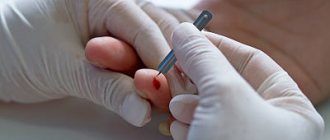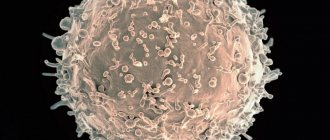Iron deficiency
Worms
Allergy
40507 August 10
IMPORTANT!
The information in this section cannot be used for self-diagnosis and self-treatment.
In case of pain or other exacerbation of the disease, diagnostic tests should be prescribed only by the attending physician. To make a diagnosis and properly prescribe treatment, you should contact your doctor. We remind you that independent interpretation of the results is unacceptable; the information below is for reference only.
Clinical blood test: indications for use, rules for preparing for the test, interpretation of results and normal indicators.
Detailed description of the study
Laboratory testing to determine the basic qualitative and quantitative characteristics of blood, including a complete blood count (CBC), erythrocyte sedimentation rate (ESR according to Westergren) and leukocyte formula (Leukocyte formula).
Blood is a liquid tissue that circulates in the circulatory system. It consists of a liquid intercellular substance - plasma, and formed elements - erythrocytes, leukocytes, platelets. In a healthy person, the chemical and cellular composition of the blood is relatively stable, but reacts to any changes occurring in the body.
A clinical blood test is the most important comprehensive laboratory test when examining a person with any disease. Changes in the studied parameters, as a rule, occur long before the appearance of visible symptoms of the disease.
The following indicators are determined as part of the study:
- hemoglobin concentration;
- red blood cell count;
- platelet count;
- leukocyte count;
- hematocrit;
- average red blood cell volume;
- average hemoglobin content in a red blood cell;
- average hemoglobin concentration in an erythrocyte;
- blood color index;
- absolute and percentage content of various leukocyte populations in the blood;
- erythrocyte sedimentation rate.
Detailed description, as well as features of interpretation of values:
3.1.1. General blood analysis
3.5.1. Leukocyte formula
3.3.1. Erythrocyte sedimentation rate
Indications for analysis
Such studies are most often carried out to identify the causative agent of syphilis in a large group of the population. The main purpose of such an analysis is mass production, which is necessary for further diagnosis if a positive result is obtained.
Typically, a blood test for microreaction is prescribed:
- in places of deprivation of liberty;
- upon admission to the hospital;
- pregnant women;
- before surgery;
- military personnel;
- during preventive examinations at the place of work;
- blood donors.
This rapid diagnostic method is also widely used for final monitoring after treatment of the disease. After all, the microprecipitation reaction is one of the most reliable methods.
Blood collection procedure
Usually, for a general analysis, blood is taken from a finger, and for biochemical and other types - from a vein. However, if a detailed general analysis is needed, then more material will be required, and it is difficult to take a lot of blood from a finger. Anyone who has ever donated blood from a fingertip remembers how difficult it is for a health worker to squeeze out just a few drops.
For advanced analysis, blood will be taken from a vein, usually from the cubital fossa or from the veins of the forearm or hand. The hand is freed from clothing. Place an oilcloth pad under the elbow. The hand is lowered down. A tourniquet (venous cuff) is placed slightly above the elbow on a napkin or underwear. The health care worker feels the pulse and finds the most saturated vein. Then you need to clench your fist several times, then close it.
Blood is collected using vacuum systems. It is collected in several test tubes that differ in appearance by the color of the caps. Each tube is intended for its own purpose - one or more tests. For example, hematological studies are carried out only in whole – non-clotted blood. To prevent blood from clotting, special reagents are added to the test tube. These tubes have purple (EDTA) or green (heparin) caps. On the contrary, all biochemical tests are performed with serum. It settles during blood clotting. Silicon dioxide is used for this. Vials containing silicon dioxide have red caps.
After drawing blood, the tourniquet will first be removed, and only then will the needle be removed from the vein. An alcohol cotton ball is applied to the puncture site. You need to clasp your hand at the elbow and hold it like that for about 3-5 minutes. If you squeeze your hand poorly, a hematoma will form. Therefore, there is no need to check whether the puncture is bleeding or not. Keep your hand clamped for at least 3 minutes!
What is the norm of indicators in the analysis?
To understand whether everything is in order or not, you need to know the norm for each indicator. There are differences between indicators for patients of different ages and genders, so they are taken into account. We are talking about middle-aged men and women and children from 7 to 12 years old.
- Hemoglobin in men ranges from 130 to 160 g/l, in children from 110 to 145, and in females – from 120 to 140.
- The red blood cell count is 4.0 – 5.1 x 1012 for males, 3.5 – 4.7 x 1012 for children and 3.7 – 4.7 x 1012 for women.
- Blood color 0.85 – 1.15.
- Reticulocytes in children, as their body grows, range from 3 to 12%. With age, the norm falls, and a middle-aged person of any gender has 0.2-1.2%.
- Platelets are within the range of 180,320×109, and in the younger generation they are less than 160,380×109.
- Erythrocyte sedimentation rates vary. The norm for children is 4 12 mm/h, for women – 2-15 mm/h, for men – 1 10 mm/h.
- Leukocytes – 4.0 9.0×109.
- Bands in the blood of adults are 1-6%. Children have small frames - from 0.5 to 5%.
- Segmented in the blood from 47 to 72%, and in children the range is lower - from 35 to 65%.
- Eosinophils in a healthy adult body range from 0 to 5%. In children, the rate is normal – from 0.5 to 7%.
- Basophils should not exceed 1%; the norm will be if the form indicates 0 in the indicator column.
- Lymphocytes in the children's body - 24-54%. In adults, the rate is lower – from 18 to 40%.
- Monocytes in both men and women of any age should not fall below 2% or rise above 9%.
False test results
There are times when a blood test may show unreliable or false results. This can happen if the test technology has been violated. An erroneous result can be obtained if the test material is collected incorrectly. Incorrect mixing of ingredients, their contamination, violation of storage technology - all this can lead to an erroneous result.
Positive false results can also occur, for example, in the presence of pathological conditions in the body. Therefore, it is necessary (before making a final diagnosis) to conduct additional studies to identify possible pathologies. False positive results can occur when:
- pregnancy;
- the presence of neoplasms;
- diabetes mellitus;
- viral liver diseases;
- inflammation of both lungs or tuberculosis;
- for gout;
- autoimmune and other pathologies of any origin;
- alcoholism and drug addiction.
Thus, a blood test for microreactions makes it possible to detect the disease in time and begin treatment.
General blood test and blood biochemistry – NEARMEDIC laboratory
When is it recommended to perform a blood chemistry test?
The transcript of the detailed blood test indicates the blood parameters obtained after the study and the norms of the detailed blood test established for them.
Thus, a specialist can immediately detect deviations in indicators in one direction or another. The norms for a complete blood test differ for men and women. Below are the main indicators of analysis and the standards established for them. Hemoglobin (Hb, Hgb).
This is the main component of red blood cells, through which oxygen is transported to organs and tissues. Lack of hemoglobin is called anemia and leads to oxygen starvation of tissues. The hemoglobin norm for women is 120-140 g/l and 130-150 g/l for men.
Medical experts say that blood diagnostics, which are carried out in different laboratories, can give different results. This is due to the fact that each medical laboratory has different technical equipment for carrying out diagnostics. Therefore, the final results of the same analysis differ.
But the norms for the main indicators in a general blood test have been established. If there are any deviations in human health, the standards may be too high or too low. For example, leukocytes may be elevated due to various types of infections, the presence of fungi, or disorders of the liver and circulatory system. What can a blood test show for rubella, measles, hepatitis, as well as kidney failure and radiation? It should be answered that it can only show low levels of leukocytes.
Increased platelet standards may indicate the presence of inflammatory processes in the lungs, as well as exacerbation of chronic diseases. A reduced level of platelets in the blood appears during infectious and viral processes, as well as with excessive use of antibiotics or allergic medications.
An increased hematocrit is observed with erythremia, dehydration, polycystic kidney disease, and hemoglobinopathy.
4. Platelets are small platelets of blood that take part in the formation of a blood clot at the site of vessel damage, preventing blood loss. According to the transcript of a detailed blood test, the norm of platelets in adults is 180-320?109/l, in newborns - 98-421?109/l.
A decrease in the number of platelets in the blood (thrombocytopenia) is a sign of megaloblastic anemia (with deficiency of vitamin B12 and folic acid), malignant lesions (leukemia, sarcoma, myelofibrosis), some viral infections, Wiskot-Aldrich and Fanconi syndromes.
An increased platelet count (thrombocytosis) occurs in myelofibrosis, erythremia, rheumatoid arthritis, rheumatic fever, osteomyelitis, tuberculosis, and ulcerative colitis.
The normal content of red blood cells in the blood is [3]:
An increase (erythrocytosis) in the number of red blood cells occurs when:
A slight relative increase in the number of red blood cells may be associated with blood thickening due to a burn, diarrhea, or taking diuretics.
A decrease in the content of red blood cells in the blood is observed when:
- blood loss;
- anemia;
- pregnancy;
- hydremia (intravenous administration of large amounts of fluid, that is, infusion therapy)
- with the outflow of tissue fluid into the bloodstream while reducing edema (therapy with diuretics).
- reducing the intensity of red blood cell formation in the bone marrow;
- accelerated destruction of red blood cells;
With viral and bacterial infections, the number of leukocytes in the blood decreases, as well as with leukemia, radiation sickness, and purulent processes.
Granulocytes are a subgroup of leukocytes. They are divided into basophils, eosinophils, neutrophils and perform a protective function. A low granulocyte count may indicate a serious autoimmune disease. An increase is usually caused by an infection.
Lymphocytes, monocytes Lymphocytes and monocytes are also subgroups of leukocytes. Lymphocytes play an important role in maintaining the immune system. They are formed in the bone marrow and lymph nodes. They can be divided into T lymphocytes (responsible for cellular immunity) and B lymphocytes (responsible for the production of antibodies).
Norm: up to 10 mm/hour in men, up to 15 mm/hour in women.
An increase in ESR is characteristic of inflammatory processes and anemia.
May occur in old age, during pregnancy, menstruation and the postpartum period.
A reduced ESR can occur with dehydration - diarrhea, vomiting, and viral hepatitis.
Treatment is prescribed by a therapist.
HEMATOCRIT VALUE
Normal for children: 32.5-55, men – 37.5-53, women – 32-43.5 (depending on age).
Deviations from the above standards are a signal that the functioning of the body is impaired, and measures must be taken to restore it. It should be remembered that only a qualified specialist can correctly evaluate the results of the analysis. Independent deciphering of the analysis results and, even more so, self-diagnosis are unacceptable, since an incorrect diagnosis usually leads to treatment for a completely different pathology, which is fraught with serious consequences for the body.
A clinical blood test is a laboratory test aimed at studying the composition of human blood. When performing the analysis, the quantitative composition of blood cells, their ratio and properties are calculated.
By changing the blood formula, one can judge the presence of anemia, inflammatory processes, bacterial and viral infections, allergies, blood diseases and other diseases. Also, a general blood analysis will show how acute the process is.
This study is an indispensable tool in diagnosing diseases and monitoring their treatment. Therefore, it is included in a number of mandatory tests during clinical examination of the population.
You can donate blood for analysis in our clinic, in the manipulation room. If necessary, you can use the service of calling a nurse to your home or office.
The transcript and norms of the general blood test will be sent to you by email or given to you on a printed form in person. You should know that the result obtained is not the basis for making a diagnosis - only the attending physician can correctly assess the indicators.
Blood is the connective tissue of the body, which consists of a liquid part (plasma) and blood cells - red blood cells, leukocytes, platelets, as well as proteins, mineral salts, hormones and other components.
Blood performs many life-supporting functions - it delivers nutrients, hormones and oxygen to organs, and removes toxins.
It is present in every organ of every system of the body, which means it is sensitive to the slightest changes in its work.
We can say that blood is the most important immune organ.
It is in it that T-lymphocytes are located - helper and killer cells, which are the first to rush to the source of infection and destroy it, as well as phagocyte cells that “eat” foreigners that enter the body.
By changing the composition of these cells, we can conclude whether the immune system is in a state of normal “working mode,” an intense struggle, or a depressed state. Therefore, a general blood test is so important for assessing the condition of the human body. Depending on the purposes, it is used both as a primary screening and an independent diagnostic procedure.
Based on changes in the number of cells, their ratio and properties, the doctor makes a conclusion about the general state of human health.
What does a general blood test show:
- the presence of inflammation in the body;
- the presence of a viral or bacterial infection;
- allergic reaction;
- intoxication;
- dehydration;
- blood diseases, including malignant ones;
- anemia;
- blood viscosity disorders;
- mononucleosis.
The analysis refers to non-specific studies. This means that it can only signal about the listed pathologies, but not diagnose them.
If the norm of a clinical blood test , one can make an assumption about the presence and intensity of pathological processes in the body, but it is impossible to judge where exactly the disease is localized and what pathogen it is caused by. Therefore, when pathological results are obtained, narrower instrumental and laboratory examinations are prescribed. For example, X-ray diagnostics, ultrasound, bacterial cultures, immunological and biochemical studies.
But, if a diagnosis is already available, the progress of treatment is monitored using a general blood test. Also, based on its result, one can tell whether the patient has an exacerbation of a chronic disease and how severe it is.
This study is performed for any acute or long-term symptoms of the disease, such as:
- catarrhal phenomena;
- temperature increase;
- pain of any location;
- acute digestive disorders;
- weakness, sweating, loss of appetite;
- weight loss without objective reasons.
A clinical blood test is prescribed for adults and children during events that require clinical examination - admission to educational institutions, permission to certain types of professional activities, trips to a sanatorium. For preventive purposes, all people should undergo this test at least once a year.
For this study, both capillary and venous blood are used. This means that material can be collected from a finger or from a vein.
This can be done in the manipulation room of our clinic. You can also donate blood at home, but in this case it is important to comply with all aseptic and antiseptic standards. Therefore, the procedure should be trusted exclusively to professionals.
- It is recommended to avoid physical overload and exposure to extreme temperatures.
- You should not eat 8 hours before the procedure.
- The day before you should exclude heavy foods - fatty, smoked, spicy, as well as alcohol.
If you are constantly taking any medications, tell the doctor who referred you for testing.
When they say “ general blood test: normal and abnormal,” they mean a number of mandatory parameters that are included in its list.
Hemoglobin (Hb or Hgb) is an iron-containing protein that is part of the red blood cell. Binds to oxygen in the lungs and transports it to tissues and organs. It also performs the opposite function, taking carbon dioxide from tissues.
- A decrease in this indicator in the analysis may indicate blood loss, iron deficiency anemia, bone marrow diseases, or renal pathology.
- The increase is associated with an increased number or volume of red blood cells due to thickening of the blood, possible heart or pulmonary failure. A significant increase in the indicator may indicate blood cancer.
cells (RBC) are red blood cells. These blood cells have this color due to the iron-containing hemoglobin that is part of them. They carry out oxygen exchange in tissues, delivering oxygen to them and removing carbon dioxide.
- An increase in their number is associated with dehydration, hypofunction of the adrenal glands, and heart defects.
- A decrease may indicate iron deficiency anemia, vitamin B12 deficiency, or suppression of bone marrow function in malignant processes.
MCHC color index is the average hemoglobin concentration in a red blood cell. A decrease occurs with various types of anemia.
Erythrocyte sedimentation rate (ESR) - in laboratory conditions, the ability of these cells to settle under the influence of gravity is studied. An increase in this parameter indicates the presence of an inflammatory process in the body - the higher it is, the more pronounced the inflammation.
- Slight increases may occur during pregnancy and menstruation in women, as well as with anemia.
- A significant jump speaks in favor of severe pathological processes - sepsis, autoimmune diseases, malignant tumors.
Platelets (PLT) are cells involved in the blood clotting process. When a vessel is damaged, a clot (thrombus) forms, clogging the wound and preventing blood loss.
- An increase in their level indicates inflammatory processes, cancer, tuberculosis, and anemia.
- Decreased – infectious diseases of a viral or bacterial nature, autoimmune processes, lack of vitamin B12 and folic acid.
Leukocytes (WBC) are white blood cells. These blood cells are an essential component of the immune system. They come in different types: lymphocytes, monocytes, neutrophils, eosinophils, basophils. Each of them performs its own function. Therefore, during a general blood test, leukocyte indicators are considered both in absolute value and in the ratio of their types - the leukocyte formula.
- An increase in the level of white blood cells is called leukocytosis. It can be caused by natural causes - physical activity, pregnancy, childbirth, severe temperature changes. But in this case it will not be significant.
Leukocytosis is observed in acute and chronic infections, inflammatory processes, poisoning, severe hypoxia, blood diseases, purulent processes, myocardial infarction, and severe allergies.
Leukopenia is a decrease in the number of leukocytes. Talks about suppressed immunity. It is observed with viral infections, radiation sickness, taking certain drugs (cytostatics, antibiotics, corticosteroids), certain forms of leukemia, spleen disease, with a long and severe course of infectious and inflammatory diseases (in this case, the initial leukocytosis is replaced by leukopenia).
- The peculiarity of these leukocytes is that they can be found in the lymph. These cells protect the body from the penetration of external agents - bacteria and foreign substances.
- Lymphocytosis – viral infections, tuberculosis, whooping cough, asthma.
- Lymphopenia is a drop in immune status caused by various reasons.
- They belong to phagocytic cells - that is, absorbing foreign agents. Their function is aimed at fighting infections - bacteria, fungi, parasites. They are divided into segmented and rod.
- Increased – the presence of bacterial infection, tissue inflammation (heart attacks, burns, gangrene), intoxication, cancerous tumors.
- Decrease – some types of bacterial, viral and fungal infections, bone marrow diseases, including metastasis.
- Immune cells. Participate in the synthesis of interferon. Working as phagocytes, they “eat” dead and abnormal blood cells, as well as the remains of dead bacteria.
- Increased – infectious and parasitic diseases, collagenosis, trauma and surgical interventions.
- Decrease - insignificant does not play a diagnostic role.
- A significant increase occurs with aplastic anemia, long-term use of corticosteroids, and bone marrow diseases.
- Absorb and dissolve foreign protein.
- Increased – allergic reactions of the body, the presence of helminthic infestation.
- Decrease - occurs during the acute period of an infectious disease. The appearance of eosinophils in this case indicates the beginning of recovery.
- The smallest group of leukocytes.
- Their levels increase during allergic reactions.
Normal values may vary between laboratories depending on the units of measurement.
General blood test is normal for an adult:






